Introduction
Australia is the sixth biggest country in the world and the smallest continent. It lies between the Pacific and Indian Ocean, about 3,000 km from the mainland of Asia.
It is very far away from Europe and by plane it takes you over 20 hours to get there. Australia is often called Down Under because the whole continent lies south of the equator .
All of the world’s climates are found on the continent – from the tropical rainforest in the north to the cool and temperate climates in the south and southeast.
Australia was once a British colony and after its discovery in 1788 people from Great Britain settled there. In the past decades people from all over the world have come to Australia. Today it is a multicultural society .
The continent is also one of the richest countries in the world. It produces wool and meat on one side, as well as gold, bauxite and other minerals on the other. Australians have a high standard of living .
Image : TUBS, CC BY-SA 3.0, via Wikimedia Commons
Facts
| Size: | 7.7 square kilometres |
| Population : | 25 million |
| Capital: | Canberra |
| Biggest Cities: | Sydney (5.2m), Melbourne (4.9m) |
| Currency: | Australian Dollar |
| Flag: | A British flag with five small stars that show the Southern Cross . One large star represents the country’s six territories. |

Regions of Australia
Most of Australia is flat. The highest part of the country lies in the east. Australia can be divided into three big regions:
- The Great Dividing Range or Eastern Highlands
- The Central Lowlands
- The Western Plateau

Regions of Australia
Source : https://freevectormaps.com/australia/AU-EPS-01-0001?ref=atr
The Eastern Highlands are the highest parts of the continent. This region is also called the Great Dividing Range because the rivers that flow down the eastern slopes end in the ocean and the rivers that run down the western slopes flow into the Central Lowlands and dry up there.
The highest peaks can be found in the Australian Alps – in the southern part of the Great Dividing Range. They are covered with snow in winter and many Europeans go there to ski during the northern hemisphere‘s summer months.
The Central Lowlands consist of very flat plains . Rivers flow through this area after it rains a lot but during the rest of the year the river beds are mostly dry. In the southern part of the lowlands the grass gets high enough for farmers to raise cattle and sheep. Wheat is often grown here. In the northern part of the lowlands it gets drier and it is usually too hot and dry to grow crops . The region is not very populated and only has a few small towns.
The Western Plateau covers about two thirds of Australia. It is higher than the Central Lowlands. Most of it is made up of large deserts. Rain only falls in the north-eastern and south-western parts. Along the southern coast the Nullarbor Plain is about 700 km long. The name comes from the Latin words “nulla” and “arbor” which mean “no tree”.

The Great Dividing Range
Image :fir0002 flagstaffotos [at] gmail.com Canon 20D + Tamron 28-75mm f/2.8, GFDL 1.2, via Wikimedia Commons

Farming in the Central Lowlands
Image:Cgoodwin, CC BY-SA 4.0, via Wikimedia Commons

Western Australia
Image:Yewenyi at the English-language Wikipedia, CC BY-SA 3.0, via Wikimedia Commons
Australia’s Climate
Australia lies south of the equator , so its seasons are different from those of the northern hemisphere.
The southern part of Australia has four seasons. Winters are cool and rainy and last from June to August. Summers are hot and dry and last from December to January.
The northern part of the continent has a tropical climate with only two seasons. The wet season from November to April brings a lot of rain , storms and floods . The dry season lasts from May to October.
One third of Australia is desert and gets less than 25 cm of rainfall a year. The wettest part of the continent lies in the south and southeast. It gets rain the whole year, sometimes up to 3 metres . Snow only falls in the higher places of the Australian Alps.
Droughts are a big problem in many parts of Australia. In some places it doesn’t rain for many months. This leads to bush fires and a shortage of water.

Australia – Climate Zones
Source : https://freevectormaps.com/australia/AU-EPS-01-0001?ref=atr

Bush fire near Sydney
Image :Helitak430, CC BY-SA 4.0, via Wikimedia Commons

Floods in Queensland (2010-2011)
Image: Kingbob86 (Timothy), CC BY 2.0, via Wikimedia Commons
Plants and Animals
Plants
The eucalyptus or gum tree is a classic Australian tree. It has narrow , oily leaves that look like leather and smell good, but also cause the tree to burn easily. It is one of the tallest trees in the world and can grow up to a height of 100 metres.
Tourists who wander around in Australia can find thousands of wildflowers in the country. The seeds lie in the desert during the dry season and when it rains they blossom in all kinds of different colours.

Eucalyptus forest in Victoria
Image : fir0002 flagstaffotos [at] gmail.com Canon 20D + Tamron 28-75mm f/2.8, GFDL 1.2,
via Wikimedia Commons
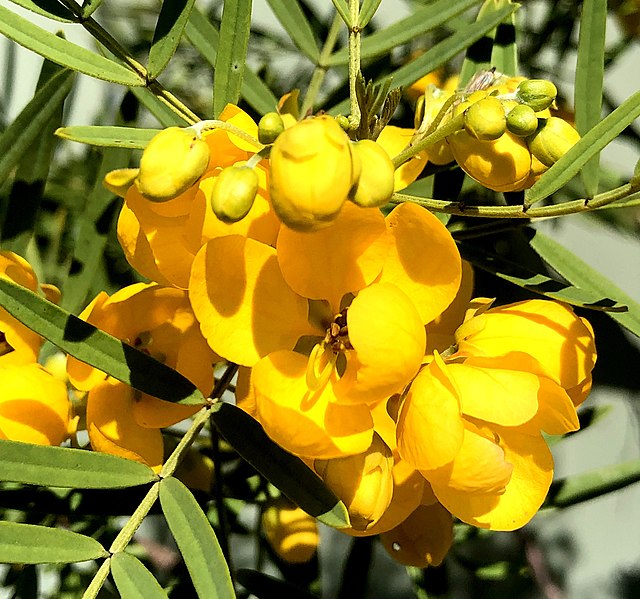
Senna odorata – flowers with a sweet smell are native to Australia
Qumarchi, CC BY-SA 4.0, via Wikimedia Commons
Animals
When the earth was formed there was only one continent . About 200 million years ago Australia was separated from this big continent and animals developed differently from those that live in other places. That is why Australia has animals which you can’t find anywhere else.
Australia’s most famous animals are marsupials. They are mammals that have their babies in pouches. Kangaroos, koalas or wallabies are the best-known marsupials in Australia. The platypus is a mammal that lays eggs, from which babies hatch.
Australia has about 700 different types of birds. Among the most famous is the kookaburra. Emus are large birds that cannot fly.
There are many species of reptiles and snakes in Australia, some of which are poisonous.

Koala
Photo by DAVID ILIFF. License: CC BY-SA 3.0
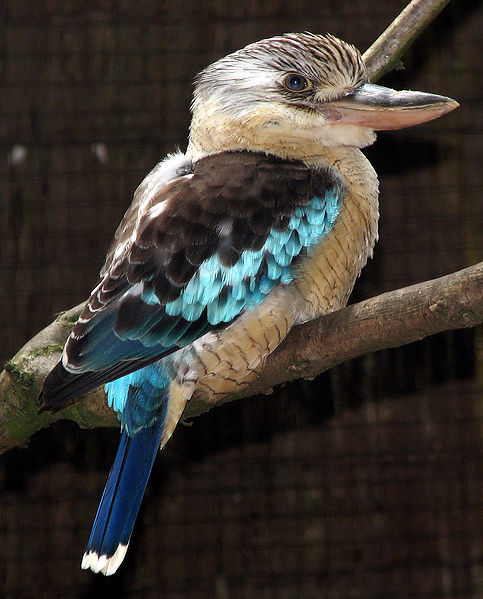
Kookaburra
Arpingstone, Public domain, via Wikimedia Commons
Australia’s Population
Australia is one of the most sparsely populated countries in the world. 9 out of 10 people live on only 3% of the land.
Most of Australia’s 25 million people live near the coast, because the inner parts are made up of deserts. 80% of the country’s population live in the south-eastern part of the country. Here you can also find the big cities like Sydney and Melbourne, or the capital Canberra.
Most people in Australia come from families who emigrated to the country from Europe. Until the beginning of the 20th century most of the immigrants came from Great Britain and Ireland. After World War II, Australia’s government allowed people from other countries to enter. Since the 1970s more and more people from Asian countries have been coming to Australia.
However, not everybody is allowed to come and live in Australia. You must pass a special test and show special skills that the Australians need.

80% of all Australians live near the coast
Source : https://freevectormaps.com/australia/AU-EPS-01-0001?ref=atr

British migrants coming to Australia after World War II
Image: Norman HerfortNorman Herfort, Public domain, via Wikimedia Commons
Aborigines
The Australian Aborigines have a history which is much like that of Native Americans. When British settlers landed on the continent at the beginning of the 19th century many Aborigines were killed or they had to leave their homes. The English took away their land. As they developed Australia they left the Aborigines locked out .
Today, some Aborigines live in cities and big towns, but they can’t always get jobs there. Many have stayed on their traditional land. There they live in small communities in the same way they did hundreds of years ago. They preserve their culture, draw paintings and sell handicrafts to tourists who pass by and visit them.
However, most of the country’s 700,000 Aborigines cannot live like the white population . They don’t have houses and medical care and most of them don’t earn as much money as white people.
Recently, the government’s feelings about their native people have changed. Over the last few decades the government has created many programmes to improve the life of Aborigines. They send them to better schools and help them get better jobs. The Australians are also starting to give them back the land that they took away from them 200 years ago.
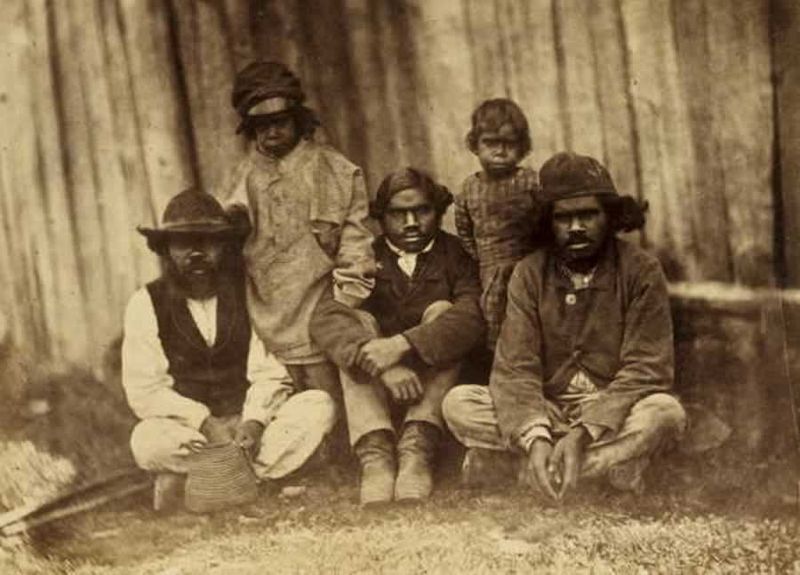
Aboriginal farmers towards the end of the 19th century
Image: Antoine Fauchery, Public domain, via Wikimedia Commons
Cities
Sydney
Sydney is Australia’s oldest and largest city, home to about 5.3 million people. It is Australia’s most important industrial city and the capital of New South Wales . Sydney’s harbour is one of the most beautiful in the world. Harbour Bridge and the Opera House are among the famous tourist attractions.
Sydney was , at first, a prison colony back in 1788. At that time, many nations sent criminals to faraway places. The first prisoners were farmers and started raising sheep. In 1848 Great Britain stopped sending prisoners to Australia and a few years later gold was discovered . Sydney started to grow very quickly. By 1890, the population was about 400,000. During the 20th century many European immigrants arrived and turned Sydney into a multi-cultural city.The people of Sydney are called Sydneysiders. About 70 % were born in Australia but in the last few decades many Asians have come to Sydney.
Downtown Sydney has many skyscrapers and office buildings, but there are also many historic buildings and parks , in which Sydneysiders can spend their free time. Many people like outdoor activities because the city has a mild climate. Sydney offers its people long beaches that attract swimmers, surfers and sunbathers .
Sydney Skyline
Image:Beau Giles, CC BY 2.0, via Wikimedia Commons
Melbourne
Melbourne is Australia’s second largest city with a population of 4.8 million. Situated around Port Phillip Bay the city is the capital and commercial centre of Victoria. Melbourne is a multicultural city . More than a third of its inhabitants arrived as immigrants from overseas. Melbourne is the home of famous art galleries, museums and festivals. Sport events take place on a regular basis. Among the most popular are the Formula 1 Grand Prix, the Australian Open Tennis Championship and the Melbourne Cup, an annual horse race. In 1956 the city hosted the Olympic Summer Games.
Melbourne was founded as a permanent settlement in 1835 and was declared a city in 1847. When gold was discovered in the 1850s, Melbourne’s rise as the centre of southern Australia started. It soon became Australia’s largest city but was eventually overtaken by Sydney. When Australia became independent in 1901 , Melbourne became the temporary capital until Canberra was completed.

Skyline of Melbourne
Image: Gracchus250, CC BY-SA 4.0, via Wikimedia Commons
Canberra
Canberra , with a population of about 300,000 is Australia’s capital . The city is built around many hills. A dam on the Mongolo River forms Lake Burley Griffen in the middle of the city.
Australia’s parliament meets at Canberra. Many government buildings and other offices are situated here too. About half of the city’s people work for the government. Others work in smaller industries, trade and tourism.
When Australia became independent in 1901, the new government started looking for a place to build the capital city. In 1913 construction began and in 1927 Canberra became Australia’s capital.

Parliament House in Canberra
Image:John O’Neill , GNU Free Documentation License Version 1.2
Brisbane
Brisbane, on Australia’s eastern coast, is the capital of Queensland and with a population of 2.5 million, Australia’s third largest city. It got its name from the river that flows through it.In its early days some of the first prisoners were transferred there from Sydney.
Today the city profits from its moderate climate all year long and is an attraction for people seeking outdoor activities. Although it does not lie directly on the coast, wonderful beaches are only a few kilometres away.

Skyline of Brisbane
Image:Kgbo, CC BY-SA 4.0, via Wikimedia Commons
Perth
Perth is the largest city in western Australia, and , with a population of 2 million, Australia’s fourth largest city. Because it is thousands of km away from other major cities, Perth is one of the most isolated in the world.
The city became important during Australia’s gold rush towards the end of the 20th century. As time went on, western Australia turned out to be rich in minerals. Since World War II, Perth has become the headquarters for major mining companies.

Perth
Image:Dietmar Rabich / Wikimedia Commons /
“Perth (AU), View from Kings Park — 2019 — 0435-42” / CC BY-SA 4.0
Adelaide
Adelaide is the capital of South Australia and with 1 million inhabitants, Australia’s fifth most populous city. Founded in 1936, Adelaide is the only city in Australia that was made for free settlers and not for British prisoners.
Today is a multicultural city, often regarded as the food, wine and festival capital of Australia. It also offers parks, beaches and nearby hills for various outdoor activities .

Adelaide
Image:Trentino Priori, CC BY-SA 3.0, via Wikimedia Commons
Australian Cities
Source: https://commons.wikimedia.org/wiki/File:Australia_location_map.svg
Economy
Australia is one of the world’s wealthiest countries. It exports valuable minerals and farm products to all parts of the world.
Various kinds of raw materials are produced. Many of them, however, are located in dry areas very far away from bigger cities or harbours. Workers must build railroad lines or roads to the mines, which is a reason why mining is a very expensive industry in Australia. Foreign companies come to Australia to invest money to mine raw materials .
Australia is a leading country in the production of diamonds, bauxite and lead. It also produces a big quantity of coal, iron ore and nickel. Almost all of the world’s valuable opals are mined in Australia. The country also has much of the world’s uranium under its surface.
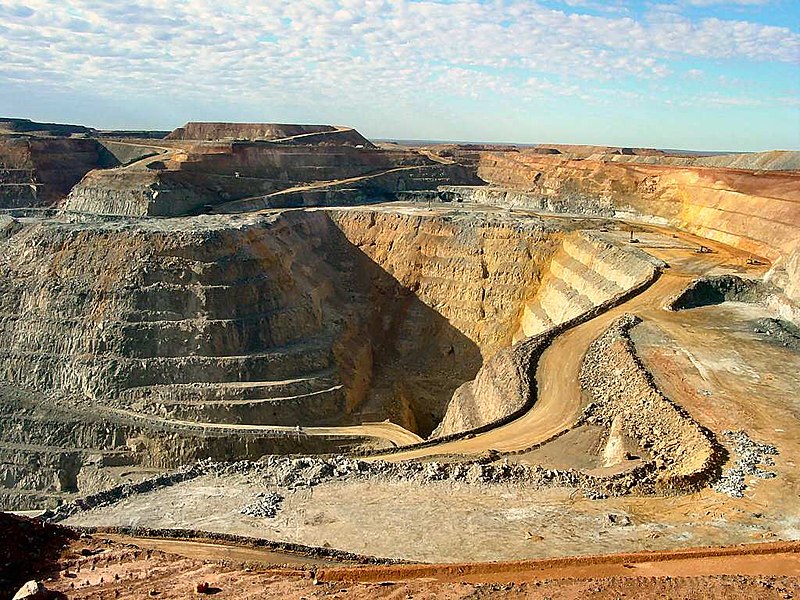
Gold mine in Western Australia
Image : Brian Voon Yee Yap
About 60% of Australia is farmland, most of which is used to raise cattle and sheep. Farmers can grow wheat in many parts of the country because wheat doesn’t need very much rain . Other products include sugar cane and bananas in the tropical north and fruits like apples, oranges and pears in the south.
Australia is the world’s largest wool producer. Most of it is exported to countries all over the world. Wine making is a part of the economy that has been growing very quickly. Grapes grow in the southern and south-eastern part of the continent and produce wine of excellent quality.

Shearing sheep in western Australia
Image:Martin Pot (Martybugs at en.wikipedia), CC BY 3.0, via Wikimedia Commons

Growing wine in Tasmania
Image: MDRX, CC BY-SA 4.0, via Wikimedia Commons
Not many people work on Australian farms because farmers have many machines to work with. Only about 5 % of the population are farmers, but they produce almost everything that the country needs.
Tourism has become very important for the economy of the country. Australia offers many sights like Ayers Rock, the Great Barrier Reef or Sydney Opera House. Because it is so far away from Europe and North America, it costs a lot to travel “down under“.
Australian Way of Life
More than 80 % of Australians live in cities or bigger towns. Most of them live in the suburbs and have their own schools, churches and shopping centres there. They live in bungalows with their own gardens. Older houses are made of wood and have verandas or porches. Some of them are built on poles . Most newer houses are made of brick or stone.
Country life in Australia is not like anywhere else in the world. The inner part of the continent is often called the outback (which means “ out in the back country ”). Farms in the outback are called stations. Farmers raise cattle and sheep and they grow wheat . These stations are very large, sometimes up to 2,000 or more square kilometres . The nearest town may be over one hundred km away.

Pub and hotel in the Australian outback
Image: www.gondwananet.com, CC BY-SA 3.0, via Wikimedia Commons
Life in the outback is very hard. There are not always paved roads , so travelling by car is difficult ,sometimes impossible. Many families have smaller airplanes which they use to get to the next town and back again. Because it is the driest region of Australia, the people in the outback must cope with natural disasters , like droughts or bush fires.
Many Australian children who live in the outback get their education at home. Students used to get their homework by two-way radio , today the internet has taken over as the main technology . Flying Doctors give medical treatment to people who live far away from doctors or hospitals.
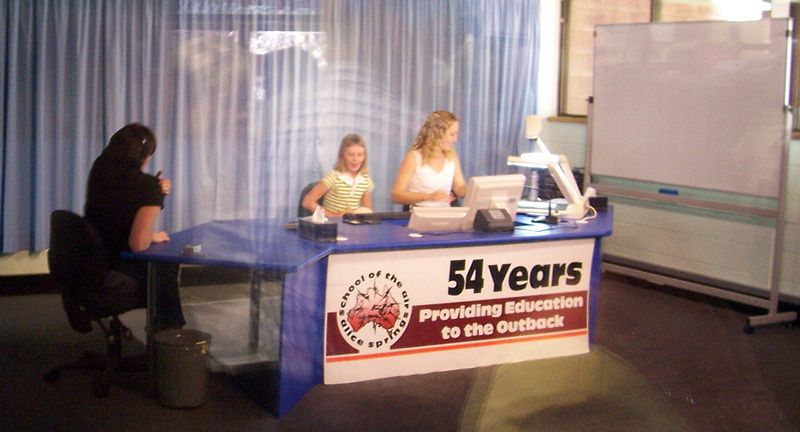
School of the Air” studio in Alice Springs
Image : Sven Tombers, CC BY-SA 3.0, via Wikimedia Commons

Planes of the Flying Doctor Service
Image : Cabrils, CC BY-SA 4.0, via Wikimedia Commons
Australians like to eat meat , especially beef , poultry and mutton . When Europeans from other countries started to come to Australia they brought their eating habits with them. Today, you can find Italian, Greek and other restaurants all over the county.
Beer is the most popular alcoholic drink, but many Australians also like to drink wine that grows in the southern and south-eastern part of the continent. Older people still drink lots of tea – like in Great Britain – but younger ones drink more and more coffee.
Australians love sport because they spend a lot of their free time outdoors . Swimming, sailing and diving are some popular water sports. Many Australians also play golf and tennis.
The most popular team sports are cricket and rugby. Many world famous athletes come from Australia and the country has won many medals at Olympic Games and World Championships.

Sailing boats in Sydney harbour
Image: Vera & Jean-Christophe from Europe, CC BY-SA 2.0,
via Wikimedia Commons

Melbourne Cricket Ground
Image: Tourism Victoria from Australia, CC BY 2.0, via Wikimedia Commons
Places to See
The Great Barrier Reef is the biggest group of coral reefs in the world. It is more than 2,000 km long and lies off the north-eastern coast of Australia.
The coral that forms the reef is made up of skeletons of dead water animals called polyps . They are small but often light up in many bright colours. These colourful reefs and the bright colours of fish and other water animals make the Great Barrier Reef a beautiful underwater garden.
Today, the reef is a national park which millions of tourists visit every year. But there are also many problems. Oil companies have found oil in this part of the ocean and want to start drilling , but the government is working hard to protect it.

Great Barrier Reef from space
Image: NASA, taken from en:ISS, Public domain, via Wikimedia Commons
The Sydney Opera House is the most famous building in the city. It has two roofs that look like sails. A masterpiece of architecture , it stands on a peninsula that reaches into Sydney Harbour. More than 6,000 people can visit concerts, operas, theatre performances and other events. The Opera House was opened in 1973.

Sydney Opera House
Image: Bernard Gagnon, CC BY-SA 3.0, via Wikimedia Commons
Ayers Rock is a big rock that rises over 300 metres high from the plains of the Northern Territory. It is about 2.4 km long and 1.6 km wide and it takes you almost 2 hours to walk around it. The rock is often called “Uluru”, an aboriginal name.
The rock is made out of sandstone and glows red during sunrise and sunset . The Aborigines worship the rock and decorated the caves in it with paintings. Today, the land around Ayers Rock is a national park but is owned by the Aborigines.
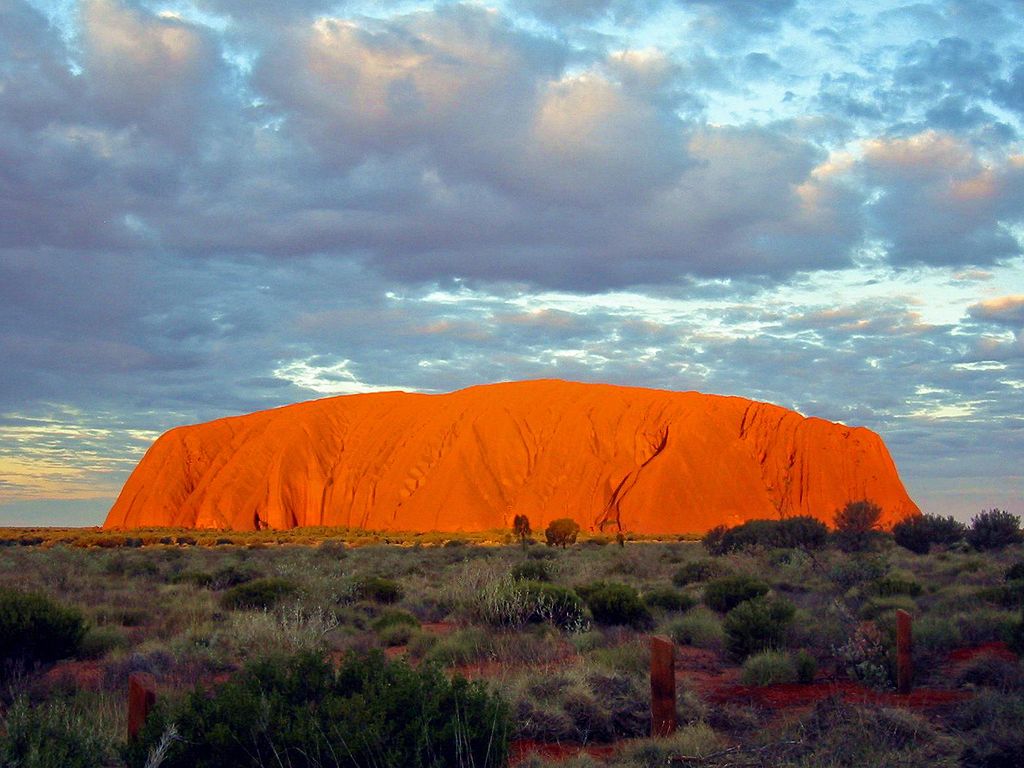
Uluru at sunset
Image: Thomas Schoch, CC BY-SA 3.0, via Wikimedia Commons
Kakadu National Park lies in Australia’s Northern Territory and covers about 20,000 square km . It is a wetland with over 200 kinds of birds and 1,000 plant species . It is also the home of Australian crocodiles.

Crocodile in Kakadu National Park
Image: Stuart Edwards., CC BY-SA 3.0, via Wikimedia Commons
The Pinnacles, located in western Australia, are made up of thousands of limestone formations that rise out of the desert floor. They were probably formed 20,00 to 30,000 years ago from marine organisms. As the years went by, winds blew away the sand and left the structures standing.
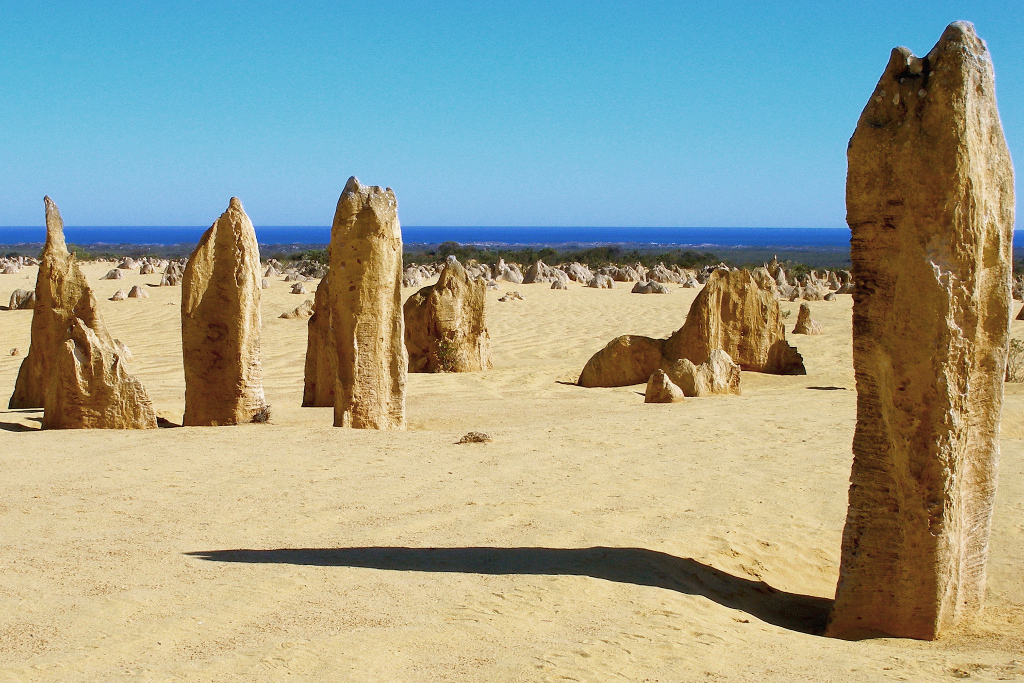
The Pinnacles
Image: Brian W. Schaller, FAL, via Wikimedia Commons
Timeline of Events
-
1770
James Cook explores the eastern coast of Australia and names it New South Wales
-
1778
Great Britain makes New South Wales a colony for prisoners.
-
1851
Gold is discovered in New South Wales and Victoria
-
1901
Australia becomes an independent country with Melbourne as its capital.
-
1927
Canberra becomes Australia’s new capital.
-
1967
The Australian government passes laws to help the Aborigines and starts giving them back their land.
-
1999
Australia’s population votes to stay a monarchy. Elisabeth II remains the Head of State.
-
2000
Sydney is host to the 2000 Summer Olympics.
Videos
Exercises
Writing Tasks
You admire Australia and have heard so much about the opportunities that the country offers, so you have decided to emigrate “down under”. Besides filling out a form with your personal data, you are required to email the immigration officials.
In this email (200 – 300 words) , you should
- tell the immigration authorities about yourself
- explain what kind of special skills you have that the country needs
- write about why you want to live and work in Australia
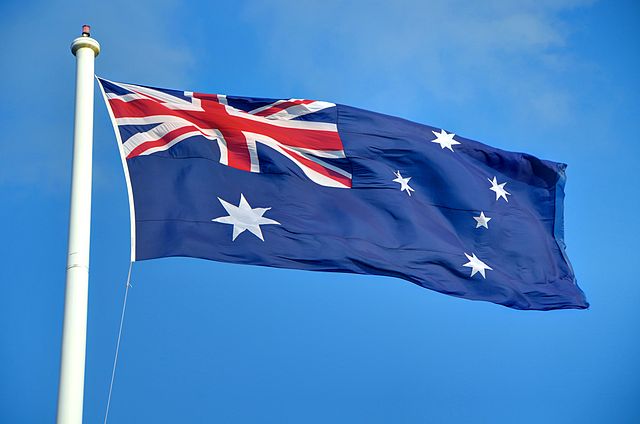
Image:Lachlan Fearnley, CC BY-SA 3.0,
via Wikimedia Commons
You are on a three-week adventure trip to Australia. On this fascinating trip, you have decided to write a diary.
Write three diary entries (about 100 words each). You should
- describe a day that, in your opinion, was the most fascinating
- write about one of the not so pleasant experiences in your trip
- write about special people who you have met in Australia
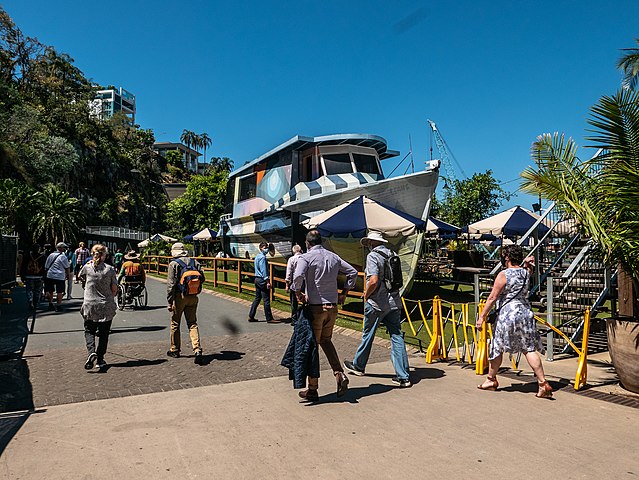
Image:John Robert McPherson, CC BY-SA 4.0,
via Wikimedia Commons